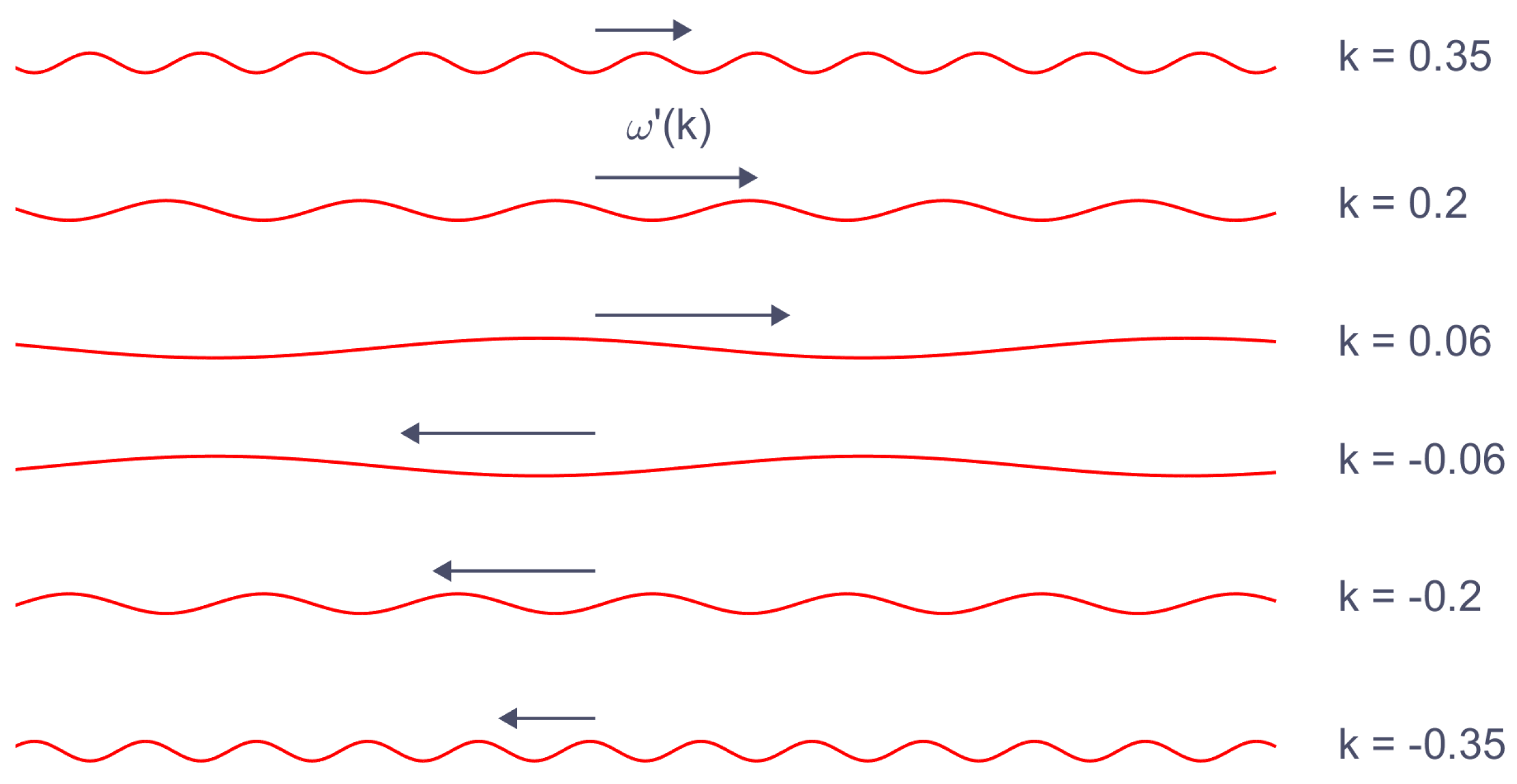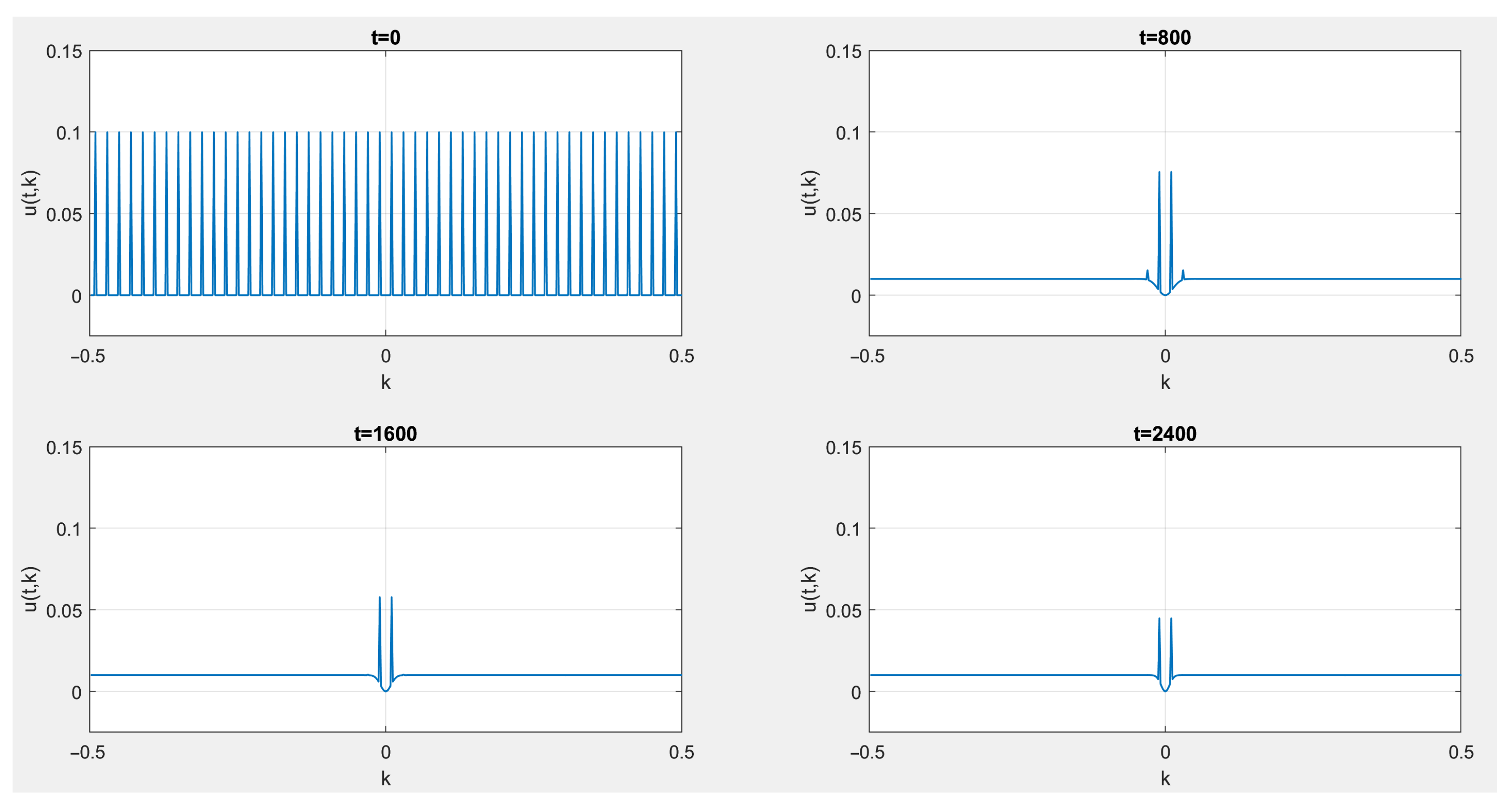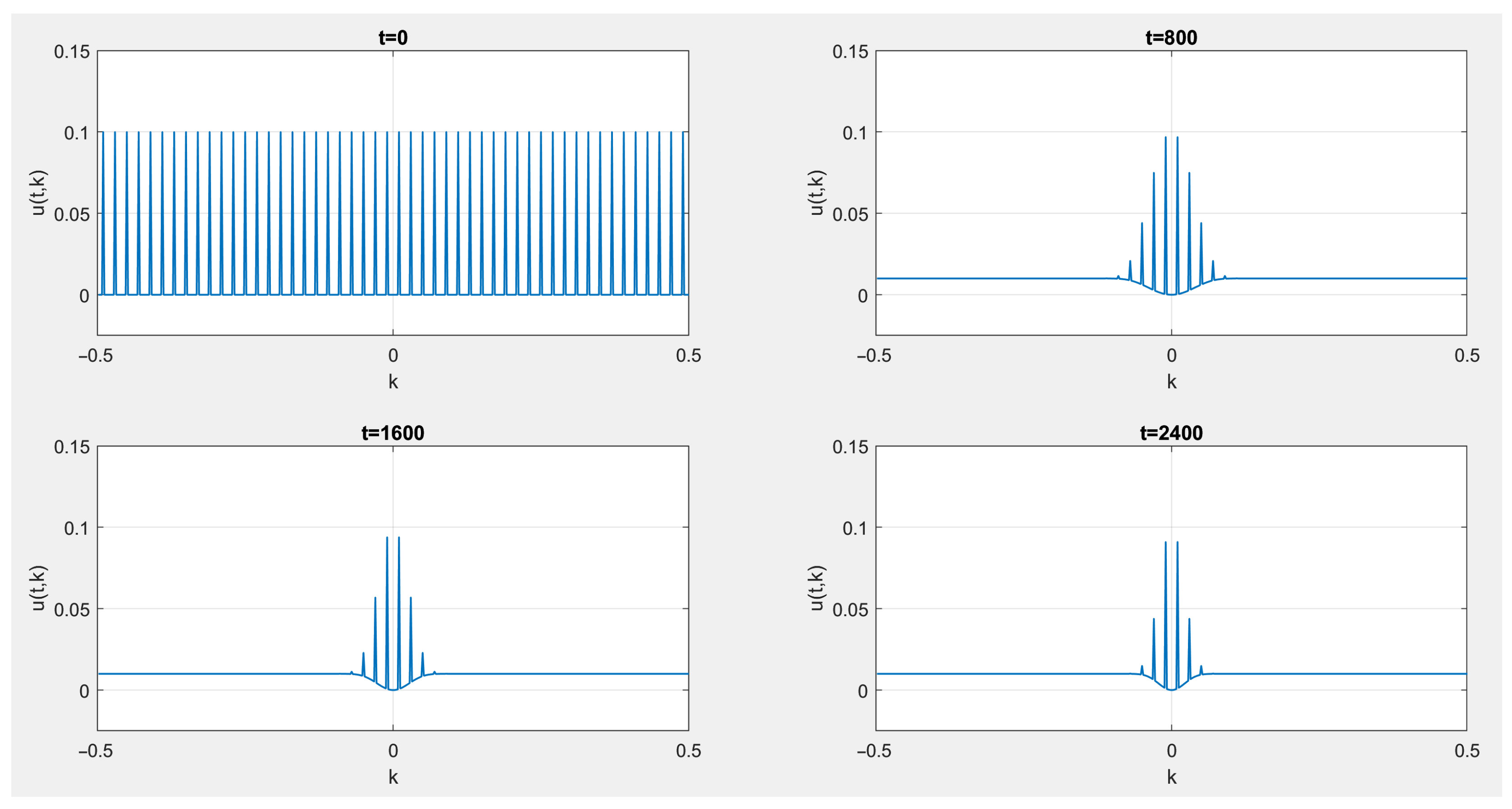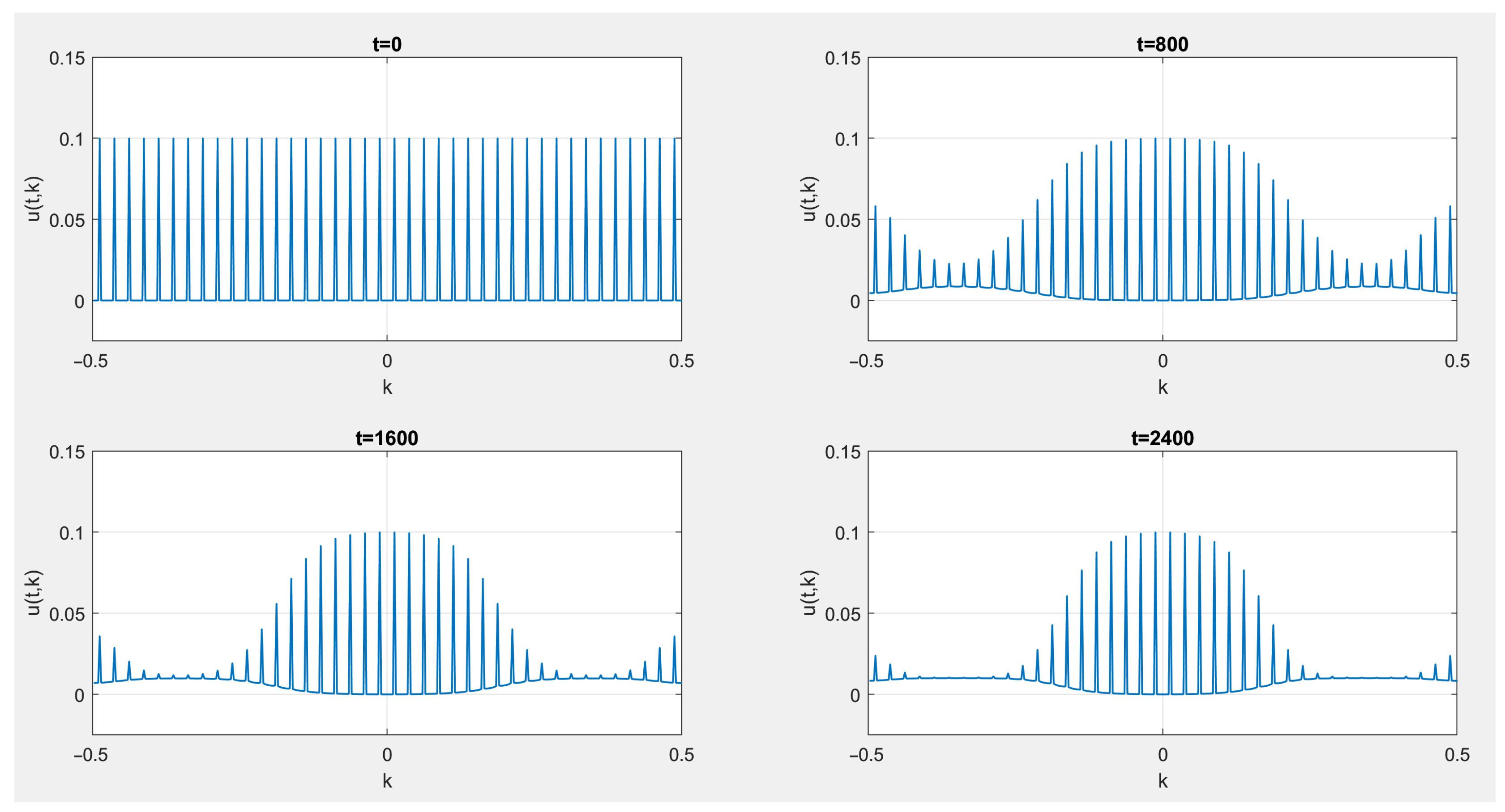A Stochastic Model of Anomalously Fast Transport of Heat Energy in Crystalline Bodies
Abstract
:1. Introduction
1.1. Stochastic Models of Heat Transport
1.2. Classical and Anomalous Heat Transport
- (a)
- The shape of the kernel, hence the parameters of phonon trajectories, emerges from the stochastic perturbation put into microscopic dynamics (6);
- (b)
- The shape of the kernel determines type of heat transport at the macroscopic scale.
2. Construction of Ornstein–Uhlenbeck Process
2.1. Mathematical Preliminaries
- Symmetric, i.e., , ;
- Positive, i.e., for all ;
- Of trace-class, i.e., satisfyingfor some (and hence every) complete orthonormal system of H.
2.2. Push-Forward Mappings and Related Abstract Wiener Measures
- —the space of sequences with finite normand the inner product
- —the dual of represented by sequences with the inner product and norm defined byThe dual relation between and is given by
- (1)
- For every and , the series , whereis convergent in and almost surely (a.s.) on Ω.
- (2)
- Let us denote by , for , a real-valued random variable almost surely given by convergent series of point (1)The sequence , as the -valued function of , is almost surely -valued. If is a -valued random variable satisfyingthen the distribution of is .
- (3)
- If , , then the series is convergent in and almost surely on Ω.
- (4)
- Let a real-valued random variable , for , be such thatThe sequence almost surely belongs to . If is a -valued random variable satisfyingthen has the distribution .
- (a)
- The measure is the push-forward measure of under :
- (b)
- with respect to ;
- (c)
2.3. Nonstationary OU Processes
- (a)
- If for some , then does and ;
- (b)
- ;
- (c)
- Given that , and , it holdsIn particular, -a.s. for every .
- (i)
- η is absolutely continuous with respect to some measure , ;
- (ii)
- for a set satisfying for all , , and .
- ⋄
- Space . If , then is the inverse Fourier transform of .
- ⋄
- If is of bounded variation, then also is for every . Now, let and assume that is of bounded variation. It follows that the seriesis convergent ([33], p. 156). If is periodic with period N, thenand this sum, as a function of , is periodic with period N as well. In particular it belongs to , so . We conclude that if is of bounded variation, then the set of all periodic sequences satisfies assumptions made on .
- ⋄
- Assume that the inverse Fourier transform of belongs to . Then, γ belongs to the Wiener algebra defined as the linear normed space of complex functions on with the norm is a Banach algebra ([34], p. 32), so belongs to for every . If is bounded, thenso and is bounded. Hence, the set of all bounded sequences satisfies assumptions on . By theorem of Bernstein ([34], p. 33), a sufficient condition for γ to be in isfor some .
2.4. Equation of Heat Energy Transport on The Microscopic Scale
3. Numerical Simulations
4. Discussion and Future Work
Author Contributions
Funding
Data Availability Statement
Conflicts of Interest
References
- Lepri, S.; Livi, R.; Politi, A. Heat conduction in chains of nonlinear oscillators. Phys. Rev. Lett. 1997, 78, 1896–1899. [Google Scholar] [CrossRef]
- Benenti, G.; Lepri, S.; Livi, R. Anomalous Heat Transport in Classical Many-Body Systems: Overview and Perspectives. Front. Phys. 2020, 8, 292. [Google Scholar] [CrossRef]
- Balandin, A.A. Thermal Properties of Graphene and Nanostructured Carbon Materials. Nat. Mater. 2011, 10, 569–581. [Google Scholar] [CrossRef] [PubMed]
- Chang, C.W. Experimental probing of non-fourier thermal conductors. In Thermal Transport in Low Dimensions: From Statistical Physics to Nanoscale Heat Transfer; Lepri, S., Ed.; Springer: Berlin/Heidelberg, Germany, 2016; pp. 305–338. [Google Scholar]
- Bernardin, C. Hydrodynamics for a System of Harmonic Oscillators Perturbed by a Conservative Noise. Stoch. Process. Appl. 2007, 117, 487–513. [Google Scholar] [CrossRef]
- Komorowski, T.; Olla, S. Ballistic and superdiffusive scales in macroscopic evolution of a chain of oscillators. Nonlinearity 2016, 29, 962–999. [Google Scholar] [CrossRef]
- Komorowski, T.; Olla, S. Diffusive propagation of energy in a non-acoustic chain. Arch. Ration. Mech. Anal. 2017, 223, 95–139. [Google Scholar] [CrossRef]
- Komorowski, T.; Olla, S. Kinetic limit for a chain of harmonic oscillators with a point Langevin thermostat. J. Funct. Anal. 2020, 279, 108764. [Google Scholar] [CrossRef]
- Lepri, S.; Livi, R.; Politi, A. On the anomalous thermal conductivity of one-dimensional lattices. Europhys. Lett. 1998, 43, 271–276. [Google Scholar] [CrossRef]
- Lepri, S.; Livi, R.; Politi, A. Thermal Conduction in Classical Low-Dimensional Lattices. Phys. Rep. 2003, 377, 1–80. [Google Scholar] [CrossRef]
- Lepri, S.; Livi, R.; Politi, A. Universality of Anomalous One-Dimensional Heat Conductivity. Phys. Rev. E 2003, 68, 067102. [Google Scholar] [CrossRef] [PubMed]
- Basile, G.; Bernardin, C.; Olla, S. Momentum Conserving Model with Anomalous Thermal Conductivity in Low Dimension. Phys. Rev. Lett. 2006, 96, 204303. [Google Scholar] [CrossRef] [PubMed]
- Basile, G.; Olla, S.; Spohn, H. Energy Transport in Stochastically Perturbed Lattice Dynamics. Arch. Ration. Mech. 2010, 195, 171–203. [Google Scholar] [CrossRef]
- Jara, M.; Komorowski, T.; Olla, S. Limit Theorems for Additive Functionals of a Markov Chain. Ann. Appl. Prob. 2009, 19, 2270–2300. [Google Scholar] [CrossRef]
- Basile, G.; Bovier, A. Convergence of a Kinetic Equation to a Fractional Diffusion Equation. Markov Proc. Relat. Fields 2010, 16, 15–44. [Google Scholar]
- Komorowski, T.; Stępień, Ł. Long Time, Large Scale Limit of the Wigner Transform for a System of Linear Oscillators in One Dimension. J. Stat. Phys. 2012, 148, 1–37. [Google Scholar] [CrossRef]
- Komorowski, T.; Stępień, Ł. Kinetic Limit for a Harmonic Chain with a Conservative Ornstein-Uhlenbeck Stochastic Perturbation. Kinet. Relat. Model. 2018, 11, 229–278. [Google Scholar] [CrossRef]
- Smith, A.N.; Norris, P.M. Microscale Heat Transfer. In Heat Transfer Handbook; Bejan, A., Kraus, A.D., Eds.; Wiley: Hoboken, NJ, USA, 2003; pp. 1309–1357. [Google Scholar]
- Basile, G.; Bernardin, C.; Olla, S. Thermal Conductivity for a Momentum Conservative Model. Comm. Math. Phys. 2009, 287, 67–98. [Google Scholar] [CrossRef]
- Bonetto, F.; Lebowitz, J.L.; Rey-Bellet, L. Fourier Law: A challenge to Theorists. In Mathematical Physics; Imperial College Press: London, UK, 2000; pp. 128–150. [Google Scholar]
- Balescu, R. Equilibrium and Nonequilibrium Statistical Mechanics; Wiley: Hoboken, NJ, USA, 1975. [Google Scholar]
- Stępień, Ł. Stochastic Processes and Heat Transport; Wydawnictwo Politechniki Lubelskiej: Lublin, Poland, 2021. [Google Scholar]
- Griffiths, D.J. Introduction to Quantum Mechanics; Prentice Hall: Hoboken, NJ, USA, 1995. [Google Scholar]
- Fermi, E.; Pasta, J.; Ulam, S. Studies of Non Linear Problems. In Collected Papers; University of Chicago Press: Chicago, IL, USA, 1965; Volume 2, pp. 978–988. [Google Scholar]
- Lukkarinen, J.; Spohn, H. Anomalous Energy Transport in the FPU-β Chain. Commun. Pure Appl. Math. 2008, LXI, 1753–1786. [Google Scholar] [CrossRef]
- Spohn, H. Nonlinear Fluctuating Hydrodynamics for Anharmonic Chains. J. Stat. Phys. 2014, 154, 1191–1227. [Google Scholar] [CrossRef]
- Da Prato, G. An Introduction to Infinite-Dimensional Analysis; Springer: Berlin/Heidelberg, Germany, 2006. [Google Scholar]
- Shigekawa, I. Stochastic Analysis; Translations of Mathematical Monographs; American Mathematical Society: Ann Arbor, MI, USA, 2004; Volume 224. [Google Scholar]
- Adler, R.J. Geometry of Random Fields; Wiley: Hoboken, NJ, USA, 1981. [Google Scholar]
- Janson, S. Gaussian Hilbert Spaces; Cambridge University Press: Cambridge, UK, 1997. [Google Scholar]
- Stroock, D.W. Abstract Wiener Space, Revisited. Commun. Stoch. Anal. 2008, 2, 145–151. [Google Scholar] [CrossRef]
- Kukush, A. Gaussian Measures in Hilbert Space, Construction and Properties; Wiley: Hoboken, NJ, USA, 2020. [Google Scholar]
- Edwards, R.E. Fourier Series, A Modern Introduction, 2nd ed.; Springer: Berlin/Heidelberg, Germany, 1979; Volume 1. [Google Scholar]
- Katznelson, Y. An Introduction to Harmonic Analysis; Cambridge University Press: Cambridge, UK, 2004. [Google Scholar]
- Ethier, S.N.; Kurtz, T.G. Markov Processes, Characterization and Convergence; Wiley: Hoboken, NJ, USA, 2009. [Google Scholar]







Disclaimer/Publisher’s Note: The statements, opinions and data contained in all publications are solely those of the individual author(s) and contributor(s) and not of MDPI and/or the editor(s). MDPI and/or the editor(s) disclaim responsibility for any injury to people or property resulting from any ideas, methods, instructions or products referred to in the content. |
© 2023 by the authors. Licensee MDPI, Basel, Switzerland. This article is an open access article distributed under the terms and conditions of the Creative Commons Attribution (CC BY) license (https://creativecommons.org/licenses/by/4.0/).
Share and Cite
Stępień, Ł.; Łagodowski, Z.A. A Stochastic Model of Anomalously Fast Transport of Heat Energy in Crystalline Bodies. Energies 2023, 16, 7117. https://doi.org/10.3390/en16207117
Stępień Ł, Łagodowski ZA. A Stochastic Model of Anomalously Fast Transport of Heat Energy in Crystalline Bodies. Energies. 2023; 16(20):7117. https://doi.org/10.3390/en16207117
Chicago/Turabian StyleStępień, Łukasz, and Zbigniew A. Łagodowski. 2023. "A Stochastic Model of Anomalously Fast Transport of Heat Energy in Crystalline Bodies" Energies 16, no. 20: 7117. https://doi.org/10.3390/en16207117




